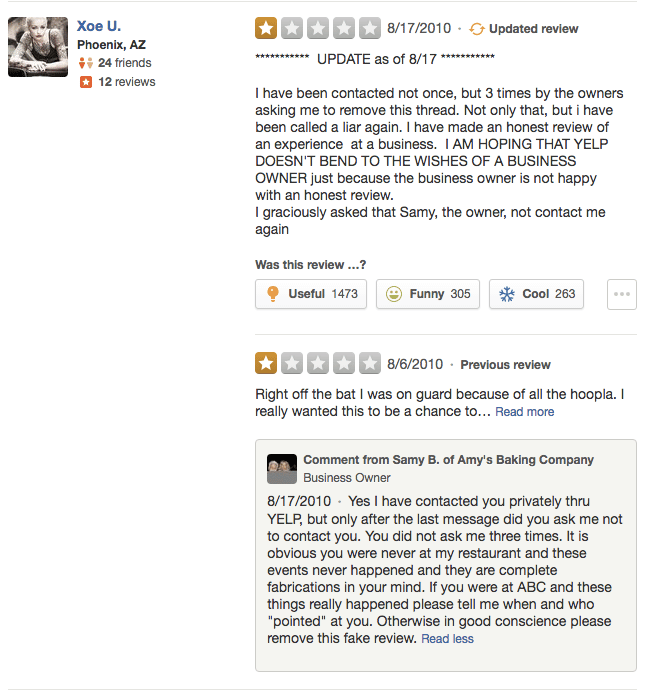Imagine this…
You sit down at your computer one fine morning, coffee cup in hand, and begin to make your online rounds.
You check all the usual things: social media, analytics, blogs, and email – until you gasp in horror and stop in your tracks.
Someone has left you a negative online review!
While this is a shocking and upsetting experience, you’re not alone.
Ever heard the saying… Haters Gon’ Hate?
The truth is that any business that works with customers on a regular basis is bound to get a bad online review or two, and while it’s never a fun situation to be in the middle of, a negative online review doesn’t have to be a catastrophe.
HelpScout reports that for every one customer who lodges a complaint, 26 customers stay silent.
Kind of sucky: but a fact.
Although it feels bad when it happens, you won’t be (anything close to) scarred for life.
By the end of today’s post, you’ll actually learn that it could be a good thing! And negative online reviews have happened to us too: so I can tell you, personally, that you’ll come out of the fire refined.

5 Key Tips You Can Put to Immediate Use in Handling A Negative Online Review
In five steps, here’s a simple breakdown of what to do post-apocalypse (after you’ve received that yucky online review).
1. Stay calm
Refer to our Keep Calm & Write On graphic. (Save it, print it out, hang it up, do whatever you like.)
You’re a business owner: you work hard for your company, and it’s understandable that finding a negative online review would make you feel hurt, sad, and even angry. If this happens, though, the first thing to do is to stay calm. Nothing good ever came from blowing up at a negative online review, and you’re liable to do irreparable damage to your company if this is the path you choose.
As a general rule, it takes 12 good experiences with a company to make up for one negative experience, so you could be digging yourself a big hole with your customers if you fly off the handle before thinking through things.
Instead of being reactionary, take a step back from the review and give yourself a bit of time to consider the situation.
Begin by sizing up the content of the review.
Is it factually correct? Is there a way to address or resolve the problem for the customer? Does the review offer insight into something your company could do well to fix, anyway?
For example, if a customer at your restaurant complains that it took 30 minutes to get a glass of water after sitting down, and you were indeed tragically understaffed that night, there’s a simple solution. In this case, the correct path would be to apologize to the customer and offer a comped or discounted meal the next time they return. Once you’ve addressed the complaint, you could even consider hiring more staff or implementing different protocols to prevent that type of situation from happening again.
If the report is factually inaccurate, however, your approach will be different. While malicious reviews don’t happen very often, they do happen. Luckily, there’s a way to deal with them. If someone is making dishonest or defamatory statements about your company, it’s within your rights to ask the third-party review site to remove the comment.
This is true regardless of whether the review is on Yelp, Facebook, or Google. Keep in mind that getting reviews removed can be an extensive and arduous process, so it’s one to undertake carefully. First of all, you’ll need to provide proof that shows the review is factually inaccurate. If you can’t do this or can’t wait for the third-party site to decide on the review, set the record straight in the comments section below the review.
Just remember to be neutral and professional to avoid making the situation worse.
Take it from Amy’s Baking Company – which won catastrophic web-wide recognition when the owners repeatedly and aggressively lashed out at a displeased reviewers on Yelp.

As if the above wasn’t bad enough…

So, there you go on a brief rundown of what not to do.
Now, let’s look at best next action steps.
2. Take Action/Offer a Solution
Customers don’t often go out of their way to write negative reviews for no reason, so it’s in your best interest to heed the review and do everything in your power to rectify the situation.
Your first case of action here is to determine if this is a legitimate customer – because you can only service the legit negativity. We hate to say it, but yes, there are people out there who will leave fake negative reviewers (are either paid by competitors, are the competitor themselves, are are acting out of personal angst).
If you know this is a stranger, and not a legitimate complainer: well, here’s one scenario you could take inspiration from.
I’m going to tell you a little story.
The Story of Jane, Bill, & Will: (Or, the Art of Handling the Fake Negative Review)

Let me run you through a story about what we’ll call Bill the Fake Reviewer Writer.
Bill heard of a made-up negative story about a company, word-of-mouth, from Jane. Jane was fired from her company just that week. At Jane’s very frequent pushing, Bill went and published a fake review on Jane’s company. He was amped up by Jane and wrote a lot of angry words, calling the company names and even going as far as to put libel on the company owner.
It was a weekend and late in the evening. Still, the company social manager was online and saw the angry posts being left by Bill; he alerted the company CEO within minutes of it happening. Let’s call that CEO Will.
Will took a breather (see #1). After ten minutes, he immediately replied to Bill, cordially starting with hello. Then he stated facts: 1) we’ve never served you and 2) please provide proof on and who is spreading information about the things you’re currently stating.
Bill couldn’t, told by Jane to not mention her name of course, and wouldn’t. Instigated by anger, he continued writing back angry comments.
Some of Will’s other employees jumped online and posted good reviews when they saw what was going on in their Facebook feed; Bill jumped on all their reviews and attacked them all.
Will took another breather (and maybe a cup of cold water). He came back and assessed the situation.
Bill was:
- not a current, past (and definitely not future) client of Will’s company
- not an employee of Will’s company
- was stating everything based on hearsay, without factual information
- was using names and saying phrases that were by now, most definitely, reputation-harming libel
Will had a good lawyer, and at this point, Bill was just posting like crazy on the company Facebook page, in the amounts of several hateful comments per few minutes.
Will decided to:
- leave a final post to Bill stating Bill’s angry posts were becoming libel, an admissible tort in court, and that Bill would be hearing from Will’s lawyer
- ban Bill from the company page
Within ten minutes after acting on this decision, Bill withdrew and deleted every comment he posted, and Will had the peace of mind knowing Bill couldn’t post again (banned) and that had he continued acting out, Will could have most definitely put his lawyer in touch.
What if It’s a Legit Customer?
If you’re not in Will’s situation, and if it’s a legitimate customer you know has a complaint about a real purchase, offer a rectification immediately.
Personally reach out and make a solution that you know they can’t refuse (free XYZ next time they come in, free mailed replacement, etc.). Just the outreach alone will mean a lot–not every company does that anymore.
Keep in mind that most customers complain because they truly had a disappointing experience with your company. While this is difficult to swallow, working together with the client to fix the situation can mend the bridges that were in danger of being burned. While it won’t necessarily erase the customer’s initial experience, it can shift their impression of your company and encourage them to come back and do business with you once more.
3. Your Business Will Keep Thriving
Let’s go back to the stat I shared early on:
HelpScout reports that for every one customer who lodges a complaint, 26 customers stay silent.
That means this is probably one out of 27 happy customers who is unhappy.
So, good going! Your business is thriving!
React to the complaint (if it’s a legit one: see #2) as if it’s a lesson from your worst critic. If a customer complains about something in your company, the best thing you can do is consider whether the review is shining a light on cracks in your business model–and learn from it.
To put this another way, it’s wise actually to be grateful for clients who complain. If they’re highlighting something specific – like slow turnaround times or poor work – it’s critical to use this feedback to improve your company and ensure that your relationships with other customers don’t suffer for it.
Negative reviews don’t always have to be a negative experience. Instead, you can use the information you gain from them to make your business stronger and more resilient in the long term.
Keep your head up–you have other happy customers out there, and your services are valuable. Don’t let this one get you down!
4. Take Your Reviews Offline
If you encounter a negative online review, and it passed our step #2 and is a legitimate complaint, one of the best things you can consider doing is to move the conversation to a more private venue.
This is important for two reasons: first of all, conducting a conversation in the public forum of a third-party review site isn’t always great for business – especially if your customer is angry or the conversation is strained. Even if your intention is not to fight viciously with your customer (and it shouldn’t be), you’re still wise to take the conversation offline.
By offering a personal email or contact number where the customer can reach out to you, you make the experience more personal and show that you genuinely do care about your company and the service you offer your clients.
Nine times out of ten, providing a customer with a personal email to reach you by shifts the tone of the conversation hugely. In addition to taking the exchange out of the public eye, it also demonstrates to the customer that you’re engaged and will take the needed steps to fix the issue.
5. Embrace Your Bad Reviews & Learn From Them
Sound like a funny fifth step? Stay with me.
There are more than 6 billion people on the planet, and if you did business with every single one of them, it’s virtually guaranteed that at least a few of them wouldn’t like your company, for one reason or another.
To put this another way, a negative online review doesn’t mean you suck. It just means there was a misstep or that there’s a weak spot in your business strategy.
Because of this, I advocate embracing your negative online reviews. The fact that a customer took the time to write a review of your company can be a boon if you let it and the feedback gained from customer reviews can be invaluable if you use it correctly.
With this in mind, respond quickly, comprehensively, and compassionately to your online reviews. While it’s not uncommon for a customer to be displeased, very few customers stay that way when met with a company that responds openly to negative reviews.
By reaching out directly to the customer, offering a resolution, and ensuring that you’ve done everything in your power to smooth things over, it’s easy to take negative online reviews and turn them into loyal customers.
Andrew’s Success Story: Bad Reviews Can Be a Business Opportunity
Take it from Andrew, who served sustainable seafood.
He saw a bunch of one-star reviews on his company, read them, and summarized from them that prices were too high and portions too small.
Andrew went and rehashed his menu, changed his prices, and invited his one-star reviewers back.
After they saw the improvements, they changed most of their ratings into five-stars.
Andrew’s business is now thriving!
Be like Andrew–learn from the negativity your customers share with you, change structures based on criticism, and think of them as your biggest “new” customer base! It’s an awesome, honest tactic.
Responding Well to Your Negative Online Review: A Critical Business Move
Negative online reviews are bound to happen, but they don’t have to ruin your company. By responding fully and compassionately to online reviews, you can secure a spot for yourself as a reputable, compassionate, attentive business that puts customer service first.
While it’s never enjoyable to find a negative online review about your company, you can use these reviews to grow your business if you approach them correctly.
Customers that complain are offering valuable insight into your company, practices, and service, and listening to them is the best and most efficient way to boost your reputation and serve all of your customers better – from beginning to end.
So while it’s natural to recoil at negative online reviews, the moral of the story is that you do not want to be like Amy’s Baking Company.
By treating negative online reviews and reviewers with respect, reverence, and concern, you can smooth out small flare-ups before they become full-fledged wildfires.
This, in turn, helps you keep your company’s reputation intact for years to come.
Need help creating content that keeps your online reputation in stellar shape? Check out our content shop today.
